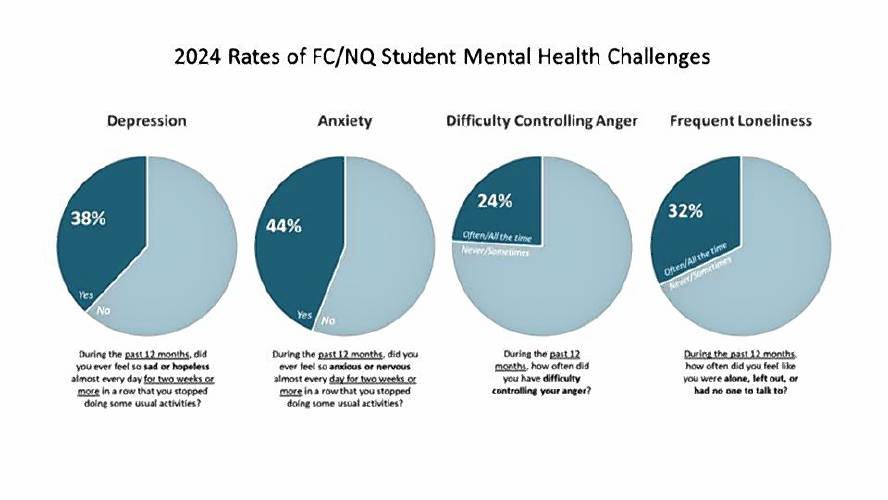Communities That Care Coalition survey shows decrease in youth self-harm, suicidal planning

Results from the Communities that Care Coalition’s 2024 Student Health Survey. CONTRIBUTED IMAGE/COMMUNITIES THAT CARE COALITION
| Published: 10-21-2024 6:05 PM |
This article is the second in a four-part series exploring the results of the Communities That Care Coalition’s 2024 Student Health Survey. The Communities That Care Coalition is co-hosted by the Franklin Regional Council of Governments (FRCOG) and Community Action Pioneer Valley.
While rates of depression and anxiety among Franklin County and North Quabbin area students have steadily increased over the last 10 to 20 years, data collected this year in the Communities That Care Coalition’s Student Health Survey indicates a slight decrease in reported self-harm or suicidal planning.
Since 2003, the Communities That Care Coalition has surveyed more than 40,000 students in grades eight, 10 and 12 from all nine public school districts in Franklin County and the North Quabbin region to evaluate youth habits and overall emotional and physical health.
In a portion of the survey titled “Youth Mental Health and Wellness,” teens were asked questions such as whether they had recently contemplated, planned or attempted suicide or engaged in self-harm, or whether they felt too anxious or depressed to take part in day-to-day activities.
Although the percentage of students who reported feeling “too depressed for usual activities” increased from 22% to 38% between 2006 and 2024, the rate of students surveyed that reported suicidal thoughts decreased from 18% to 13% between 2005 and 2024, with peaks of roughly 21% in 2018 and 2022.
“All of the measures were really increasing starting around 2012, which does coincide with when most youth got smartphones for the first time. We’re really at these pretty epidemic levels here, but fortunately, the best news that we have from this year’s survey is we’re starting to see declines,” Communities That Care Coalition Coordinator Kat Allen said. “In terms of the depression and suicide measures, we’re seeing some relief. That is not to say that we need to back off and not pay attention. They’re all still too high. We’re still at a real mental health crisis, but we seem to be doing some things right, and we need to continue and increase those efforts.”
Even though the rate of students reporting they had attempted suicide dropped from 7% to 6% from 2003 to 2024, and the rate of students who had planned suicide dropped from its peak of roughly 14% in 2022 down to 11%, Allen noted that 62% of students surveyed had consistently felt too sad, hopeless, anxious or nervous to partake in their usual activities, had difficulty controlling their anger or felt alone.
This year, however, Allen said students were not only surveyed on negative mental health challenges they had experienced, but on signs of positive mental health as well. In the 12 months prior to taking the survey, 61% of students reported feeling “happy or joyful,” while 53% reported feeling like they had a sense of control over their lives and 53% of students reported feeling “excited or optimistic.”
Article continues after...
Yesterday's Most Read Articles
Communities That Care Coalition Evaluation Coordinator Nick Hathaway said the decision to include questions about more positive mental health experiences was made in an effort to add context and perspective to the annual survey.
“It was just about giving a more robust picture of the spectrum of mental health that we’re looking at. The convention is to look at the problems, the struggles and challenges that people are having, but that’s really such a small part of the spectrum of the human experience,” Hathaway said. “Of the students that are having those ‘hard feelings,’ the majority of those students are at least experiencing those positive feelings, too. That’s not to dismiss the [mental health challenges students face].”
A demographic analysis of the survey results showed that race, age, gender identity and sexuality were all factors that correlated with mental health, noting that males generally reported more positive mental health than females or gender-diverse students, and that white and Asian students reported more positive mental health trends than their Indigenous, Latino or Black peers.
Hathaway said there was also a correlation between the amount of hours students reported sleeping each night and their mental health.
“This is a correlation that’s kind of causative in both ways. For instance, we know that more sleep and better sleep quality improves emotional regulation. We also know that anybody who’s experiencing more depression and anxiety is going to have a harder time getting good sleep,” Hathaway said. “It’s really a push and pull sort of thing, but it’s just something that we wanted to point out to encourage prioritizing sleep.”
Anthony Cammalleri can be reached at acammalleri@recorder.com or 413-930-4429.






 ‘It’s a Wonderful Night in Turners Falls’ showcases village businesses, nonprofits
‘It’s a Wonderful Night in Turners Falls’ showcases village businesses, nonprofits Sackrey Construction Co. of Sunderland celebrating 35 years in business
Sackrey Construction Co. of Sunderland celebrating 35 years in business Photo: As darkness falls
Photo: As darkness falls Leverett residents rap Kittredge compound plans, urge caution as negotiations for 400 homes move forward
Leverett residents rap Kittredge compound plans, urge caution as negotiations for 400 homes move forward 
